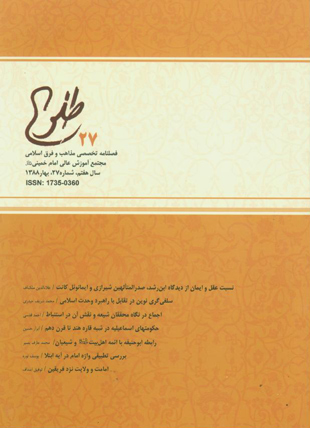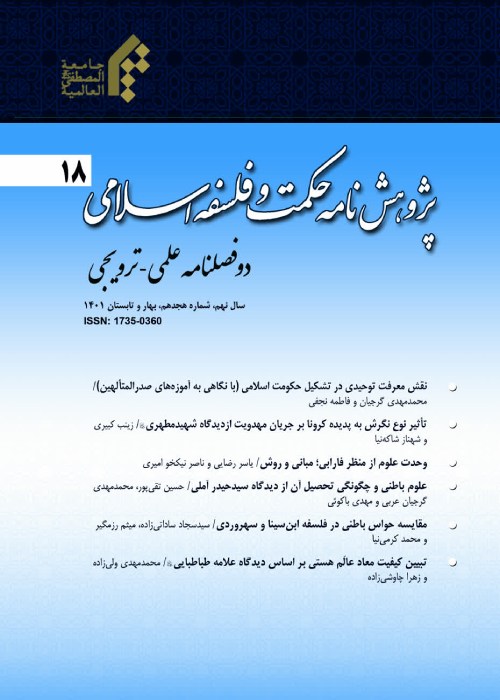فهرست مطالب

پژوهشنامه حکمت و فلسفه اسلامی
سال هشتم شماره 27 (بهار 1388)
- 156 صفحه،
- تاریخ انتشار: 1388/06/15
- تعداد عناوین: 9
-
صفحه 3مسالک مختلف کاشفیت اجماع از قول معصوم؛ نحوه تعامل فقها با اجماع در مقام نظر و عمل و نیز مسئله مشکوف از اجماع از جمله مهمترین مسایل مباحث اجماع هستند. در واقع اجماع دلیل چهارم به حساب نمی آید و با توجه به معیار حجیت در اجماع، شهرت نیز همانند اجماع می تواند حجت باشد. از این رو، بررسی اندیشه های شهید صدر راجع به حساب احتمالات اهمیت می یابد. نکته مهم دیگر این است که میزان، اجماع قدمای اصحاب است و توجه خاص فقهای طراز اول به اجماع و شهرت قدمایی امری مهم است. در این مقاله، ضمن بررسی مسایل فوق به آثار و فواید فقهی و استنباطی اجماع و شهرت اشاره و به این نتیجه می رسد که تالیف موسوعه الإجماع فی الفقه الشیعی از جمله مهمترین ضرورت در این عرصه استکلیدواژگان: اجماع، شهرت، قدمای اصحاب، عمل اصحاب، اعراض اصحاب، کاشفیت، کلیات و اصول مسائل، فروع مسائل
-
صفحه 23تفاوت فریقین در مسئله امامت، در تعریف معنای امام نیست، بلکه در تصور آنها از امام است. مسئله امامت نزد شیعه مسئله ای کلامی اما نزد اهل سنت مسئله ای فقهی است. به همین سبب، اهل سنت امامت را از فروع دین می دانند که انتخابش به عهده مردم است، اما شیعه این مقام را از اصول دین و امر انتصابی می داند. در این نوشتار ضمن بررسی موضوع فوق به شرایط امام از منظر فریقین اشاره و آرای متفاوت آنان را تبیین و تحلیل می نماید.
کلیدواژگان: امام، ولایت، عصمت، علم ویژه، اهل حل و عقد، مردم -
صفحه 41آیه 124 سوره بقره از چند منظر قابل تامل است: 1. آیه ابتلا در روایات فریقین؛ 2. مراد از کلمات مطرح شده در آیه؛ 3. مقصود از امام در آیه؛ 4. مراد از عهد در آیه؛ 5. مراد از ظالم در آیه؛ 6. نکات اعتقادی موجود در آیه و چند بحث جانبی دیگر. این مقاله به بحث امامت با روش تطبیقی تمرکز دارد و به این نتیجه می رسد که مراد از مقام امامت در این آیه هدایت تکوینی به معنای ایصال به مطلوب است.
کلیدواژگان: امام، ابتلا، تفسیر تطبیقی -
صفحه 65از منظر ابن رشد عقل و ایمان دو ابزار معرفتی در عرض یکدیگرند و هر کدام می توانند انسان را به سر منزل مقصود برسانند و هیچ تعارضی میان این دو نیست. صدرالمتالهین نیز عقل و ایمان را از یک طرف مؤید یکدیگر و از سوی دیگر مکمل هم می داند. به نظر او، هرگز میان دین حقیقی و مضامین درست و واقعی کتاب و سنت با احکام و مدرکات عقلی تنافی و ناسازگاری نیست. به نظر صدرالمتالهین هیچ آموزه دینی با هیچ معرفت عقلی یقینی ناسازگاری ندارد. در ادامه در بررسی دیدگاه کانت به این نتیجه می رسیم که کانت در باب عقل و ایمان اساسا به سمت عقلانیت عملی چرخش می نماید. به نظر کانت، ایمان خردورزانه مبتنی بر زمینه عقل عملی است و نه عقل نظری، زیرا عقل نظری توانایی اثبات درستی یا نادرستی دعاوی دینی را ندارد. چنین ایمانی از وجدان اخلاقی انسان نشات می گیرد.
کلیدواژگان: ابن رشد، صدرالدین شیرازی، ایمانوئل کانت، عقل، ایمان، نسبت عقل و ایمان، عقل عملی و عقل نظری -
صفحه 85نوشته حاضر به بررسی جریان سلفی گری نوین (وهابیت) به عنوان یکی از موانع اساسی وحدت اسلامی می پردازد. رویکرد افراطی ای که سلفیان وهابی اتخاذ نموده اند، فصل مشترکی برای گفت وگو و در نتیجه وحدت وجود نخواهد داشت. برخلاف ادعای وهابیان که مدعی پیروی از سلف صالح هستند و باورهای خود را به خصوص در مسئله تکفیر پیروان دیگر مذاهب اسلامی، به سلف منتسب می کنند، بسیاری از محققان و عالمان شیعه و سنی این ادعا را مورد انکار قرار داده اند. با بررسی و مقایسه دقیق عقاید وهابیت و آرا و اندیشه های سلف نیز به وضوح می توان دریافت که آنچه محمدبن عبدالوهاب و هواداران او در قرن دوازدهم مطرح کرده اند، با اندیشه و شیوه سلف کاملا متفاوت است.
کلیدواژگان: سلفی گری، وهابیت، وحدت اسلامی، تقریب، سلفیان، ابن تیمیه، محمدبن عبدالوهاب -
صفحه 107با ورود افرادی با عقاید اسماعیلی به سرزمین شبه قاره هند، خصوصا ورود محمد بن اسماعیل و فرزندان او، جنبش اسماعیلی در سند و ملتان، شکوه خاصی به خود گرفت. و با آمدن دعات به طور مرتب، زمینه برای تشکیل دولت اسماعیلی فراهم شد.
در قرن چهارم یک دولت اسماعیلی در ملتان و به دنبال آن در منطقه گلگت که در شمال پاکستان کنونی است، در قرن هشتم هجری قمری، یک دولت اسماعیلی به وجود آمد و در نهایت در اواخر قرن دهم قمری از بین رفت.
این مقاله ظهور و افول دولتهای اسماعیلی ملتان، منصوره و سومره را بررسی می کند.
کلیدواژگان: اسماعیلیه، شبه قاره هند، ملتان، منصوره، سومره -
صفحه 131بسیاری کوشیده اند میانه دو اندیشه برادر کوفی حنفیه و شیعه را مخدوش جلوه دهند و لذا آموزه فرعی فقهی قیاس را، آن چنان پرورانده اند که گویا از قرآن و سنت هم پیش تر است. حال آنکه امام ابوحنیفه یکی از این نابهنجار ی ها را نبودن ائمه اهل بیت در مقامشان می دانست و نیز امام ابوحنیفه نسبت به ائمه اهل بیت پیش از خود و ائمه اهل بیت زمانش، نگرش مرجعیت علمی امامتی داشت.
کلیدواژگان: ائمه اهل بین (ع)، ابوحنیفه، حنیفه، کوفه
-
Page 3Of most significant issues in consensus, various approaches to consensus reported by Imams (Pbut), theoretical and practical interaction of jurists with consensus as well as query revealed by consensus can be named. As a matter of fact, consensus is not really attributed as the forth reason. Taking the criterion of authority of consensus into account, reputation can also be a proof, just like consensus. That is why investigating martyr Sadr’s thoughts (may God have mercy on him) concerning probability turns out to be of supreme significance. The other crucial point is that, consensus of the early companions is the main criterion, and particular attention of high ranking jurists toward consensus and being reputed as early companions is of high importance. In addition to delving into fore – mentioned issues, this article discusses jurisprudential and deductive effects and advantages of consensus and reputation and comes to this conclusion that authoring Mowsuat – ol – Ijma' fi Al-fiqh A- shie (موسوعه الاجماع في الفقه الشيعي) is of utmost urgency in this era.
-
Page 23Difference between the two sects (Shiites and Sunnites) concerning Imamate does not lie in the definition of Imam, rather in their perception of Imam. For Shiites, Imamate is a theological issue, whereas for Sunnites it is a jurisprudential one. That is why Sunnites inclued Imamate in secondary principles of religion, selecting which is up to the people. However Shiites consider it to be of fundamental principles of Islam and the matter of appointment. Examining the above-mentioned issue, this article intends to mention the conditions of Imam from the view point of the two sects and illustrate and analyze their contradictory stances.
-
Page 41The 124th verse in surah Al-Baqarah (the cow) is multidimensionally worth pondering.The verse “Ibtila” in the narration of the two sects.The meaning of the words in the verse.The meaning of “Imam” in the verseThe concept of “covenant” in this verseThe definition of the term “evildoer” in the verse Doctrinal points of the verse.. .and a number of other secondary issues. This article comparatively focuses on the issue of Imamate and comes to this conclusion that by Imamate in this verse, formative guidance in the meaning of achieving desired quest is meant.
-
Page 65Ebn-e Roshd views intellect and faith as two parallel means of cognition, each of which is capable of guiding human to his desired destination and there is no contradiction between them.Sadr-ol-Mataahhelin is also of the view that intellect and faith on one hand confirm one another and on the other hand are complementary to one another. In his view, there is no incompatibility between authentic religion and real contents of holy Quran and holy prophets’ rules and intellectual perception. Delving into Kant’s opinion, we will come to this conclusion in the following parts that in the discussion about intellect and faith, Kant is fundamentally biased toward intellectuality.He holds the view that rational faith is based on practical intellect, not theoretical one, that is because theoretical intellect does not enjoy sufficient ability to prove or reject religious disputations. Such faith arises from human’s moral consciences.
-
Page 85Present article delves into the current of modern Salafism (Wahhabism) as one of the fundamental obstacles of Islamic unity. Radical approach, taken by Wahhabies leaves no common ground for negotiation and consequently unity. Unlike Wahhabies’ view point who claim to follow pious predecessor, particularly in regard with anathematizing other religious schools’ followers, plethora of Shi’a and Sunni scholars and researchers have rejected this idea. The contradiction of what Mohammad Ebn-e Abdul Wahhab and his companions have brought up, with predecessor’s thought and view point is vividly detectable through subtle investigation and comparison of Wahhabies tenets and opinions and those of predecessor.
-
Page 107Upon the arrival of some people with Ismaili beliefs to India, particularly the arrival of Mohammad Ebn-e Ismael and his children, Ismaili movement began to shine gloriously in Send and Meltan, and upon regular arrival of propagandists, the context for the formation of Ismaili government was prepared.An Ismaili government was formed in the forth century in Meltan and subsequently another one was formed in Gelgit in the 8th century AH, presently located in northern Pakistan, which was vanished in late 10th century AH. This article delves into appearance and collapse of Ismaili governments of Meltan, Mansoureh, and Soumereh.
-
Page 131Plenty of efforts have been made to make the relation between two Kofi brother thoughts, namely Hanafite and Shiism strained and consequently the secondary jurisprudential instruction of comparison has been so highly magnified as if it is in a higher stance than holy Quran and prophet’s rule. (Sunna). Whereas Imam Anu Hanifeh attributed one of this anomalies to the points that Imams (pbut) do not enjoy the appropriate stance they deserve. Imam Abu Hanifeh also viewed Imams (pbut) prior to his time and those in his time as authorities in science and Imamate.


